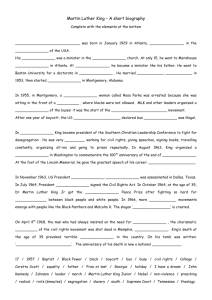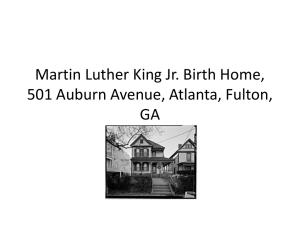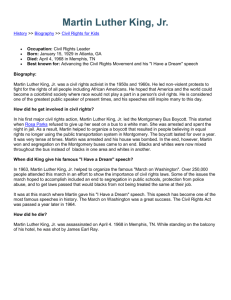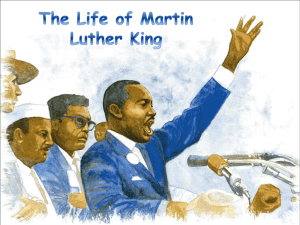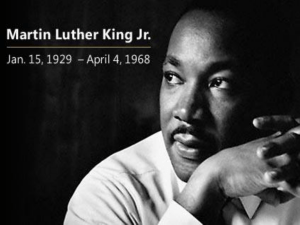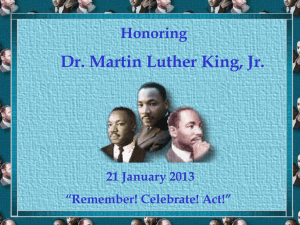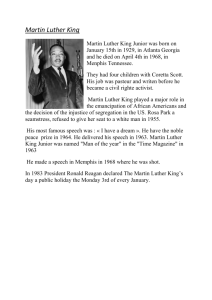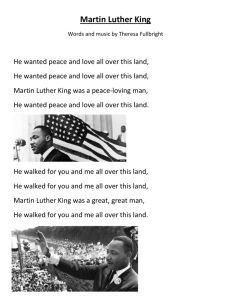MLK Bio Article - Hackettstown School District
advertisement
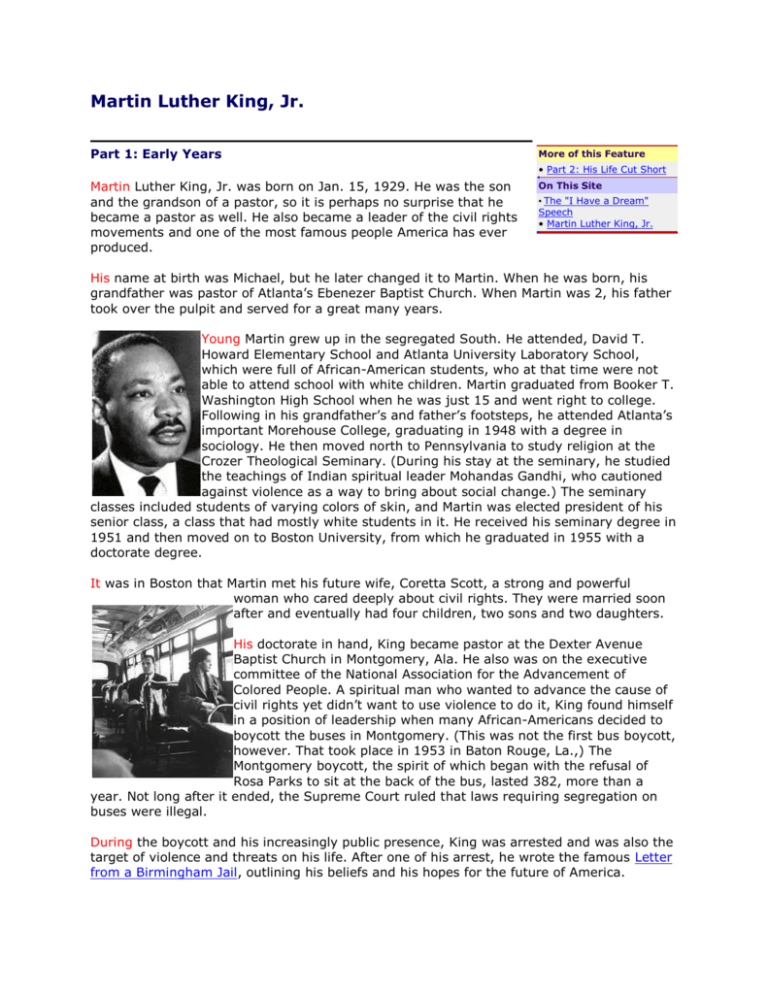
Martin Luther King, Jr. Part 1: Early Years More of this Feature • Part 2: His Life Cut Short Martin Luther King, Jr. was born on Jan. 15, 1929. He was the son and the grandson of a pastor, so it is perhaps no surprise that he became a pastor as well. He also became a leader of the civil rights movements and one of the most famous people America has ever produced. On This Site • The "I Have a Dream" Speech • Martin Luther King, Jr. His name at birth was Michael, but he later changed it to Martin. When he was born, his grandfather was pastor of Atlanta’s Ebenezer Baptist Church. When Martin was 2, his father took over the pulpit and served for a great many years. Young Martin grew up in the segregated South. He attended, David T. Howard Elementary School and Atlanta University Laboratory School, which were full of African-American students, who at that time were not able to attend school with white children. Martin graduated from Booker T. Washington High School when he was just 15 and went right to college. Following in his grandfather’s and father’s footsteps, he attended Atlanta’s important Morehouse College, graduating in 1948 with a degree in sociology. He then moved north to Pennsylvania to study religion at the Crozer Theological Seminary. (During his stay at the seminary, he studied the teachings of Indian spiritual leader Mohandas Gandhi, who cautioned against violence as a way to bring about social change.) The seminary classes included students of varying colors of skin, and Martin was elected president of his senior class, a class that had mostly white students in it. He received his seminary degree in 1951 and then moved on to Boston University, from which he graduated in 1955 with a doctorate degree. It was in Boston that Martin met his future wife, Coretta Scott, a strong and powerful woman who cared deeply about civil rights. They were married soon after and eventually had four children, two sons and two daughters. His doctorate in hand, King became pastor at the Dexter Avenue Baptist Church in Montgomery, Ala. He also was on the executive committee of the National Association for the Advancement of Colored People. A spiritual man who wanted to advance the cause of civil rights yet didn’t want to use violence to do it, King found himself in a position of leadership when many African-Americans decided to boycott the buses in Montgomery. (This was not the first bus boycott, however. That took place in 1953 in Baton Rouge, La.,) The Montgomery boycott, the spirit of which began with the refusal of Rosa Parks to sit at the back of the bus, lasted 382, more than a year. Not long after it ended, the Supreme Court ruled that laws requiring segregation on buses were illegal. During the boycott and his increasingly public presence, King was arrested and was also the target of violence and threats on his life. After one of his arrest, he wrote the famous Letter from a Birmingham Jail, outlining his beliefs and his hopes for the future of America. Martin Luther King, Jr. Part 2: His Life Cut Short The Southern Christian Leadership Conference, a leading civil rights organization, elected him president in 1957. That year, Congress passed the Civil Rights Act of 1957, the first civil rights law passed since 1875. (A second Civil Rights Act came in 1960, with the most famous ones coming in 1964 and 1965.) From that time forward, King took his case directly to the American people. It is estimated that he traveled more than 6 million miles and spoke more than 2,500 times. He also wrote five books and numerous magazine and newspaper articles during this time. In 1960, he accepted his father’s offer and became co-pastor of the Ebenezer Baptist Church in Atlanta. He served in that role until his death eight years later. One of his famous moments was a speech that he gave in Washington, D.C. On August 28, 1963, he delivered, as part of the 250,000-people strong March on Washington, a famous speech that has come to be called the “I Have a Dream” speech. Later that year, Time magazine named him Man of the Year. In 1964, he became the youngest person ever to receive the Nobel Peace Prize. (He was 35.) King promptly announced that he would turn over all of the money he received along with the award ($54,123) to help advance the civil rights movement. When he returned to the U.S. from Norway, where had accepted the Nobel award, he led a nonviolent march to promote voter registration that come to be known as the Selma-to-Montgomery Freedom March. More than 25,000 people took part. As famous as he was, Martin Luther King, Jr. was not above or below anyone. What turned out to be his final protest march was a gathering of striking garbage workers in Memphis, Tenn. He was there on April 4, 1968, in order to participate in the protest march the next day, when he was shot dead. His message of nonviolence was heeded by many and scorned by others. His hope for an America without color lines is still an ongoing pursuit, according to many people. But his name lives on as a symbol of freedom and determination. Just about everywhere you go in the world, you’ll find someone who has heard his name. You can also find his name on street signs and schools around the United States. Right next door to the Ebenezer Baptist Church in Atlanta is the Martin Luther King Jr. Center for Non-Violent Social Change. The Lorraine Hotel, where he was shot, is now the National Civil Rights Museum. And his birthday, January 15, is recognized as a national holiday.
